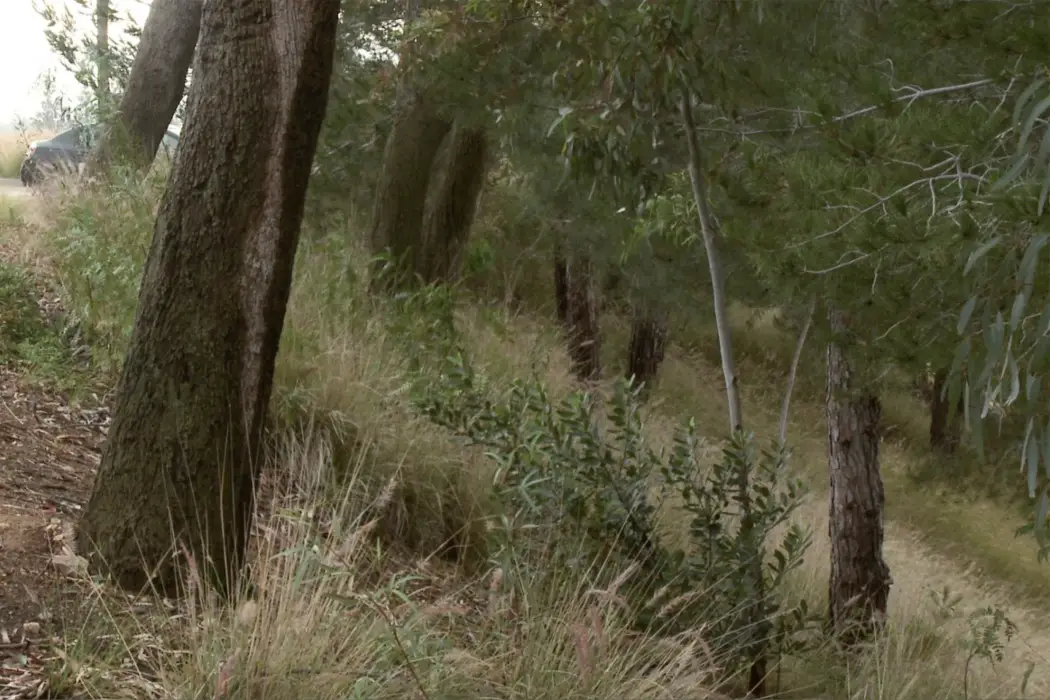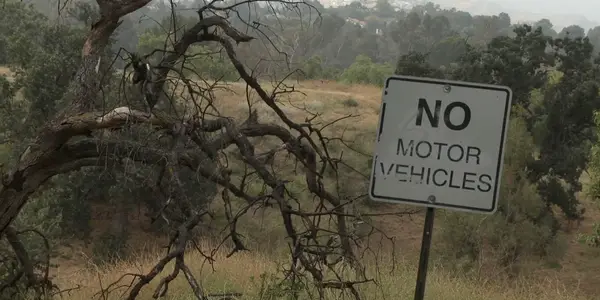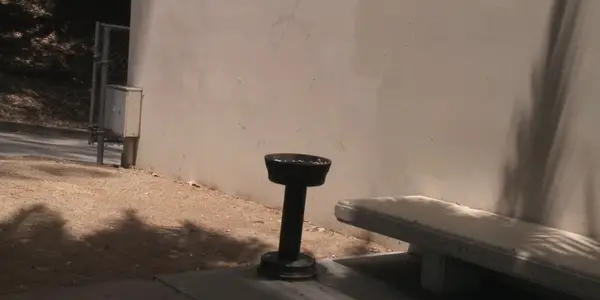MAGGIE’S FARM: Portrait Of An Art Institute

Morris is a student and cinephile from Singapore. He watches…
James Benning’s latest work examines the ghostly spaces of human inhabitation through its austere and formalist rigour.
To hope that Maggie’s Farm will win over any new converts to the filmography of James Benning would be a foolish endeavour. Few works out there are calibrated with this much banal precision as if challenging the viewer to despise its sheer mundanity and the fact that such mundanity is guaranteed critical attention (a slot at the Berlinale and the ensuing load of self-important coverage churned out by a gaggle of equally self-important critics) on account of the director’s name.
And yet for those familiar with the director’s work and methods, this is Benning at his most crepuscular – a film self-proclaimed to have been “thirty-three years in the making” ever since he began teaching at California Institute of the Arts (CalArts), where Maggie’s Farm is set. Like many of his previous films, it is slow, without a traditional narrative, and concerned primarily with the mapping of landscapes lost to the brutal scissoring of the editing table.
Portraits without People
Comprising twenty-four shots in eighty-four minutes, and featuring no actors within its frame, Maggie’s Farm documents the spaces around and within CalArts; spaces devoid of human presence, encroached upon by an air of all-colonising sterility. Each shot is approximately three and a half minutes in length, closely bookended by its predecessor and successor (and, as the press notes offer, “an urge to move forward, a tension, almost as if the landscapes and interiors were the scenes of a crime”). Minutiae of observations await the inquisitive, restless, and watchful viewers, from the infinitesimal swaying of leaves and shrubs to the distant humming of music, birds, and the expressway.

One would not be hard-pressed to imagine each shot as the potential background for a grisly murder, given their desolate seclusion from the rest of humanity. The first eight of them are of the trees, shrubs, and tall grasses that surround the CalArts campus; we open to a cluster of them, keeping at bay the relentless traffic of a motorway downhill. Following which are trees and more trees, barren earth, dense vegetation, a “NO MOTOR VEHICLES” sign overlooking a swathe of grassland foregrounded by distant suburbs, a rope tied around a tree trunk, and a puddle of stagnant water below an especially dense patch of dry weeds. Nestled somewhat awkwardly within human civilisation is this woebegone domain of nature and wilderness untamed.
The next eight shots abruptly shift to the interior of the campus, capturing its silent, overlooked corners. We see walls, corridors, stairwells, bins, hallways; drenched in fluorescent light, and filled with a silence so clinical and soulless compared to the unfiltered hummings of nature outside. Indeed, the sonic distinction between shots eight and nine – transiting from an exterior portrait of a vast canopy to an interior of acoustic ceiling tiles – can hardly be missed. In the latter shot, an exit sign shines passively, sideways from our perspective; after a full minute, an unseen door opens in the distance and the sound of footsteps slowly approaches us. A lift door opens, and their unseen owner steps in; right after, its machinery whirrs.
The final eight shots are, strikingly, amalgamations of both interior and exterior, charting the tenuous co-habitation of man-made and natural. An outdoor stone bench, a shed, a garbage dumpster, ventilation pipes, a van, and what look like shipping containers. Natural sounds dominate, but so does an insistent droning – for a few of the shots – coming from possibly a power generator or an air conditioning unit. Much like those of the shrubbery and vegetation, these are the forgotten backyards of the Institute, accessed only by the unseen legions of cleaning and maintenance staff.
For a film situated in and ostensibly about an art institute, Maggie’s Farm has a deliberately ugly choice of subjects. The elements of its portraits and landscapes are drab and unassuming, venturing beyond the quotidian and into a reality both physically and ideologically rejected by most. Few, for instance, would stroll past the garbage dumpster and ventilation pipes on either an orientation tour or a casual morning walk. When one speaks of CalArts or searches it up online, such spaces would hardly appear relevant; they would, after all, not look out of place in an industrial plant or a hospital morgue.

This reality is best epitomised in three of the film’s twenty-four shots, each featuring an avenue of waste disposal (in shot 10, a wheelable trolley operated by the janitors; in shot 16, a grey trashcan camouflaged against the grey laminated floors; in shot 21, the dumpster – “BURRTEC WASTE INDUSTRIES, INC.”) tucked away from pleasant sight. To reduce an art institute to its most fundamental signifiers of waste and health is both scathing and deeply humanising: while Benning himself concurred, during the premiere’s Q&A, that academic institutions have seen tuition fees skyrocket and students piled with even greater debt, it would be equally apt to interpret the cleaning accessories and disposal containers, along with their caretakers, as an underappreciated but essential part in the larger ecosystem. For any dwelling or habitat to function smoothly, it has to be periodically maintained.
I Ain’t Gonna Work For, Nah
Maggie’s Farm borrows its title from Bob Dylan’s eponymous blues song, in which he wearily lambasts the dehumanising quality of commodification and reification – “I ain’t gonna work on Maggie’s Farm no more / […] The way she makes me / Scrub the floor”. The song itself is absent from Benning’s film, but a few questions are invoked by its title alone. Per the images of cleaning materials and weary disuse, the film seems to be quite literally centered around the hollowness of higher-learning academia in promulgating the fanciest of intellectual theories while their physical locations fall into disarray. Benning, however, recalls no such animosity towards CalArts, where over three decades he claims to have taught the finest students within a lively and conducive learning environment.
What, then, to make of this and the other two songs that appear in the film? Shot twelve, featuring a blackboard on wheels, has the faint melody of Dylan’s Girl from the North Country, which gets amplified very slightly in the following image of a series of lockers, upon one of which is graffitied “POO BUTT. 2014”. Shot seventeen, first to meld the natural and the constructed, consists of a stone bench and an ashtray littered with cigarette stubs. Linda Ronstadt’s Blue Bayou wafts in, gently; number eighteen finds us facing a shed, with Ronstadt’s vocals noticeably louder and clearer (“Where the folks are fun / And the world is mine / On Blue Bayou”).
Both songs – Girl from the North Country and Blue Bayou – describe a loss of things past, the former an estranged sweetheart and the latter an idyllic hometown left in search of economic prosperity. As the tinny melodies of either song are piped diegetically to us, they haunt the very locations captured simultaneously onscreen. The corridors and exteriors of CalArts have an unseen and illustrious history to themselves; decades of students, teachers, caretakers, their conversations and ruminations, lunch breaks, and late-night wanderings. Restrained to static sequences and absent locations, Benning leaves it to us to imagine their ghostly reconstructions, displaying through his contemplative and methodical rhythm an inextricable relationship between buildings and their inhabitants, whether or not the latter is formally present.

Returning to the film’s title, one may allude to the idea of a work-practice disrupted by automation and dispassionate artificiality. It might be quite the stretch to read the entirety of Maggie’s Farm as a diatribe against consumerism, but then again, what portraiture of the arts wholly fixates itself on the industrial-grey behemoths of container boxes and corrugated walls? Maggie’s farm could very well be the Institute, erected on natural land for the purpose of cultivating man-made schools of thought and practice; the remnants of nature surrounding it lie just between the farm and the city, yet to be ruled by man but precariously holding on for survival.
Most of the shots in Maggie’s Farm are horizontally inclined, capturing their subjects diagonally, not quite in a direct, ontologically straightforward fashion. There is a lot unseen, avoided by the lens, almost as if the mundane were being fetishised over the possibility of glimpsing a larger picture (whole corridors and buildings, for instance). In the trashcan shot (number 16), an unseen figure opens a door, and light – presumably from the doorframe – falls into the shot, illuminating the bin; a few seconds later, the door closes and the light recedes. The figure is gone as if it had never been there.
A Landscaping Legacy
Maggie’s Farm was shot in just three days: commencing on 4th July 2019 (America’s Independence Day), Benning shot the footage on the day itself, before returning the following day to capture sound; the 6th was dedicated to splicing the two together. In a way, neither the sounds nor the music heard is truly diegetic to the footage – separated by a day, but well-hidden by the illusions of geographic proximity and, luckily for him, similar weather conditions on both dates. Hardcore formalists might have a bone to pick with this one, but I suspect that Benning, himself a formalist through and through, would shudder at this sort of superficial dogmatism.
In the film’s penultimate shot, we confront an empty space, an uninhabited corner fenced off from an elevation, beyond which are benches and tables – a foyer, sort of? A television or radio broadcast somewhere streams some baseball commentary, and a singer’s rendition of The Star-Spangled Banner, the American national anthem. This is probably the most lacklustre and meaningless shot, mapping a space of nothingness, but one sees the aged concrete and cracked paint, alongside bits and pieces of leaves, dust, tissue paper. The anthem is sung in its entirety, and the detritus do not budge.
Like Benning’s previous films, Maggie’s Farm contends with spaces and landscapes in austere and uncompromising detail. In particular, those of human inhabitation are meticulously observed, documented, and presented honestly – not in the sense of revealing some complete truth about their history and geography, but of avoiding the trappings of cuts and embellished aestheticisation. Little of the film attempts to assert some social-realist dogma of fetishised poverty in displaying the grimiest, most antithetical objects to be found in as prestigious a school as Benning’s own CalArts.
In L. COHEN (2018), which directly precedes this one, Benning films a farm field in Oregon and captures something wholly unexpected and breathtaking. Before long, Leonard Cohen’s Love Itself soothingly graces the film with the singer’s poetic lyrics and affecting vocals. Maggie’s Farm is hardly this sentimental. After thirty-three years, Benning concludes his teaching legacy with a blue van, partly obscured from the frame, against the backdrop of a building. He does not even drive off. The image simply cuts to black.
What are your favorite Bennings films? Let us know in the comments below!
Maggie’s Farm is currently streaming on Amazon Prime.
Watch Maggie’s Farm
Does content like this matter to you?
Become a Member and support film journalism. Unlock access to all of Film Inquiry`s great articles. Join a community of like-minded readers who are passionate about cinema - get access to our private members Network, give back to independent filmmakers, and more.
Morris is a student and cinephile from Singapore. He watches just about anything under the sun, with the exception of mediocre feel-good comedies. His favourite film is "The Room" (2003), an excellent feel-good comedy.













